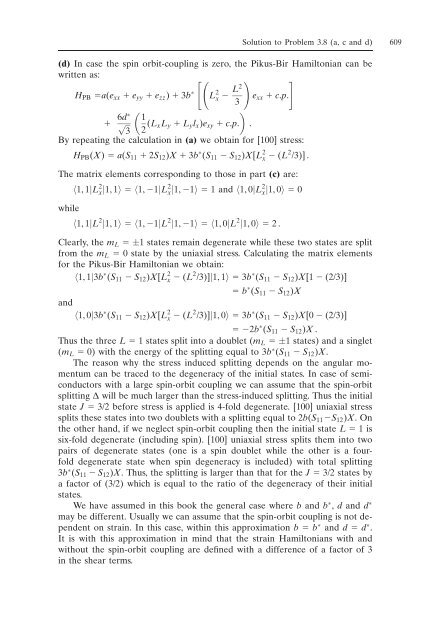10. Appendix
Create successful ePaper yourself
Turn your PDF publications into a flip-book with our unique Google optimized e-Paper software.
Solution to Problem 3.8 (a, c and d) 609<br />
(d) In case the spin orbit-coupling is zero, the Pikus-Bir Hamiltonian can be<br />
written as:<br />
<br />
L 2 L2<br />
x <br />
HPB a(exx eyy ezz) 3b ∗<br />
exx c.p.<br />
3<br />
6d∗<br />
<br />
1<br />
√<br />
3 2 (LxLy<br />
<br />
Lylx)exy c.p. .<br />
By repeating the calculation in (a) we obtain for [100] stress:<br />
HPB(X) a(S11 2S12)X 3b ∗ (S11 S12)X[L 2 x (L2 /3)] .<br />
The matrix elements corresponding to those in part (c) are:<br />
while<br />
〈1, 1|L 2 x|1, 1〉 〈1, 1|L 2 x|1, 1〉 1 and 〈1, 0|L 2 x|1, 0〉 0<br />
〈1, 1|L 2 |1, 1〉 〈1, 1|L 2 |1, 1〉 〈1, 0|L 2 |1, 0〉 2.<br />
Clearly, the mL ±1 states remain degenerate while these two states are split<br />
from the mL 0 state by the uniaxial stress. Calculating the matrix elements<br />
for the Pikus-Bir Hamiltonian we obtain:<br />
〈1, 1|3b ∗ (S11 S12)X[L 2 x (L2 /3)]|1, 1〉 3b ∗ (S11 S12)X[1 (2/3)]<br />
b ∗ (S11 S12)X<br />
and<br />
〈1, 0|3b ∗ (S11 S12)X[L 2 x (L2 /3)]|1, 0〉 3b ∗ (S11 S12)X[0 (2/3)]<br />
2b ∗ (S11 S12)X .<br />
Thus the three L 1 states split into a doublet (mL ±1 states) and a singlet<br />
(mL 0) with the energy of the splitting equal to 3b∗ (S11 S12)X.<br />
The reason why the stress induced splitting depends on the angular momentum<br />
can be traced to the degeneracy of the initial states. In case of semiconductors<br />
with a large spin-orbit coupling we can assume that the spin-orbit<br />
splitting ¢ will be much larger than the stress-induced splitting. Thus the initial<br />
state J 3/2 before stress is applied is 4-fold degenerate. [100] uniaxial stress<br />
splits these states into two doublets with a splitting equal to 2b(S11S12)X. On<br />
the other hand, if we neglect spin-orbit coupling then the initial state L 1is<br />
six-fold degenerate (including spin). [100] uniaxial stress splits them into two<br />
pairs of degenerate states (one is a spin doublet while the other is a fourfold<br />
degenerate state when spin degeneracy is included) with total splitting<br />
3b∗ (S11 S12)X. Thus, the splitting is larger than that for the J 3/2 states by<br />
a factor of (3/2) which is equal to the ratio of the degeneracy of their initial<br />
states.<br />
We have assumed in this book the general case where b and b∗ , d and d∗ may be different. Usually we can assume that the spin-orbit coupling is not dependent<br />
on strain. In this case, within this approximation b b∗ and d d∗ .<br />
It is with this approximation in mind that the strain Hamiltonians with and<br />
without the spin-orbit coupling are defined with a difference of a factor of 3<br />
in the shear terms.










